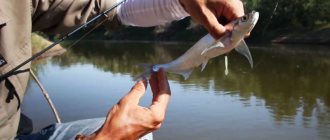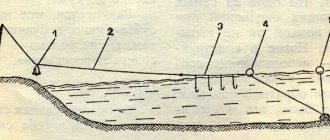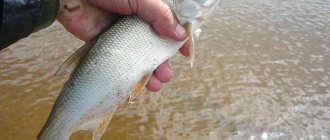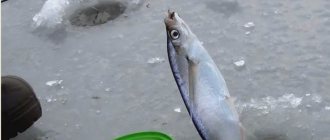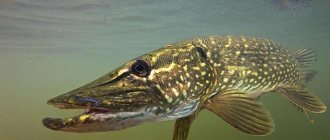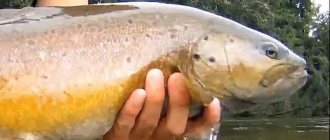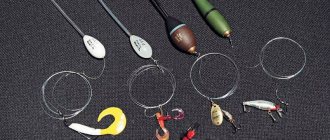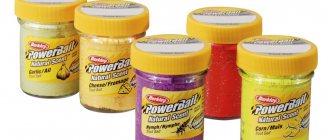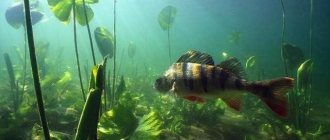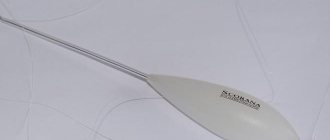To catch sabrefish on a feeder, you need to deviate somewhat from the usual tactics of feeding and bottom fishing. This fish moves in the water column; it does not feed from the bottom, as it is simply not adapted for this. The feeder is positioned as a bottom tackle, however, with the right approach, you can also catch riding fish with this tackle - sabrefish, shemai, bleak. Let's look at how to catch sabrefish on a feeder purposefully, what equipment and fishing techniques to use.
Catching sabrefish on a feeder
Chekhon is a pelagic fish, like shellfish and bleak. It feeds in the water column in schools, grabbing everything it can catch in flight, including small fry. Therefore, many fishing methods work for this fish, including tyrants and small spinning baits. There are no problems with the bite and its implementation when catching saberfish - the silver saber always grabs greedily and boldly. In water it can reach breakneck speed. Its entire body constitution shows this - a keel on the belly, a slender body, long fins similar to wings.
The main difficulty when catching sabrefish is choosing a place and finding fish. If you managed to find it and choose the right fishing horizon, there will be a catch. Chekhon is not picky about the bait and the delicacy of the equipment - the main thing is to find a feeding flock. This is the main difficulty of fishing for it.
Chekhon lives in large and medium-sized rivers and in their reservoirs. Often it stands far from the shore, located in the water column with great depth. Therefore, finding it in wide expanses of water can be difficult. However, the favorite places of saberfish are constant, and local fishermen know where to catch this fish. For fishing with a feeder rod, we are primarily interested in those rivers where sabrefish can be reached from the shore. These are either known points of its permanent habitat, or rivers in which it rises to spawn in the spring.

It is the fishing of sabrefish in the spring that is considered the best period for such fishing - at this time this fish can be caught where it is usually not found. In addition, in the spring the saber does not feed selectively, greedily grabbing any bait. After spawning, sabrefish disperse, gradually moving to permanent habitats. It no longer makes sense to catch it purposefully - there are isolated bites from individual individuals that happen to be close to the bait. Another zhor occurs in the fall - in places where schools of this fish are constantly stationed. Read more about fishing for saberfish.
What should you use to catch saberfish?
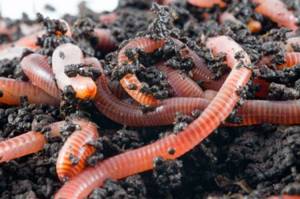
We can say that sabrefish is an omnivorous fish and yet it prefers baits of animal origin. It could be:
- muckworm;
- bloodworm;
- maggot;
- live bait;
- grasshopper;
- fly;
- dragonfly;
- butterfly;
- wasp;
- gadfly, etc.
As practice shows, saberfish are especially partial to maggots. A combination of maggot and bloodworm works well. Therefore, when going fishing with the aim of catching sabrefish, you should have the main bait with you - maggots.
As a rule, several, from 2 to 5 maggots, are attached to the hook. Moreover, the best option may be a combination of maggots of different colors. Shades of white and red or white and yellow work well. Nowadays it’s not a problem to purchase multi-colored maggots at specialized retail outlets or to grow them yourself if you wish. You should not get too carried away with colors and two colors are absolutely enough.
Chekhon prefers to take bait suspended in the water column. Therefore, in addition to bait, it is better to attach a foam ball to the hook. In this case, the foam is attached first, and then the bait. As a rule, in such cases, hooks with a long shank are used so that all the necessary elements fit on it.
When using live bait, large sabrefish are caught more often, although the size of the live bait should not exceed 4 cm. Still, sabrefish cannot be larger than pike, so it makes no sense to use larger fry.
In the summer, when there is an abundance of various insects in nature, saberfish are excellently caught on them. These could be butterflies, wasps, various bugs, grasshoppers, etc.
Various tackles, such as a feeder, a float rod or a spinning rod, are suitable as a tool for catching sabrefish. The saber fish are caught both stationary and in the wiring.
Fishing spots
Chekhon loves space and a lot of water. This is not a riding fish - rather, it prefers to stay in mid-water, following layers containing a lot of food. But it can also catch on the surface, rising there for insects and fry. Occasionally, sabrefish bite at the bottom, accidentally falling on bottom gear while lowering the bait.
Common Habitats:
- In large rivers and reservoirs, saberfish can be found anywhere in the depths and expanses of deep water - flocks migrate in search of food. Here you need to search near the shore with sufficient depths - there are at least some landmarks. These may include strandings near the jet, sandbars extending deeper into the water, underwater belly buttons and high spots. Chekhon, one might say, is like bleak, only in much smaller quantities and a much larger size.
- It is easier to find it in medium rivers. The favorite places of sabrefish are shallows with riffles near holes, sandy and rocky slopes protruding far into the water, overhanging trees from which living creatures fall into the water. It is better to check with local fishermen about permanent places of presence.
- In the spring, sabrefish go upstream into the tributaries to spawn. In the pre-spawning period it can be found with a feeder and in relatively small rivers. Usually these are the same riffles with a current and depths of no more than two meters.
- Deltas and bays of river confluences before spawning. Here saberfish can gather in huge flocks. Therefore, perhaps, this is the only case when a large-scale starting feeding of the feeder can work in order to retain some of the many fish rising upstream. The rest of the time - search fishing, frequent feeding in small quantities, to create a dust cloud, like on a bleak.
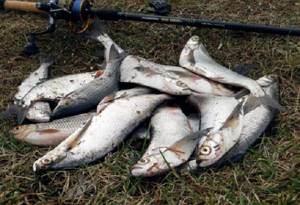
Choosing bait for spinning fishing
Bait of various types, but small in size, is attractive to predators. It is better to take several effective bait options for fishing, since taste preferences may differ in each body of water.
What baits are catchy:
- small spinners of oscillating type. Spoonfish with a silver tint are “in demand” among sabrefish in most reservoirs. Other effective micro-spreaders are “yoke” and “individual”, but they are designed for trout; the spinners will have to be modified a little. We recommend replacing the single hook with a tee, then the bait will become more suitable for sabrefish;
- small spinners of the rotating type. The most commonly used are No. 1, 0 and 00 from different manufacturers. The only drawback of this type is its low weight, which makes long-distance casting impossible. During migration and zhora, spinners show good results;
- silicone twisters of various colors are included in the bombard tackle - a special float designed for long casts. It has to be made manually: 2-3 leashes are attached to the main fishing line, more often a twister is hung on one, and a fly on the second. The role of fastening is performed by a carabiner. The leashes are made of fluorocarbon, there is no minimum of 10 cm between each fastening. It is recommended to use a drop-shaped sinker weighing 20-40 g. For the float, you should make a limiter, fixed at a distance of 20 cm from the top nozzle;
- floating wobblers of the HKML type - poppers and minnows. They are a Japanese development; they create iridescent colors in the material. Used for surface fishing (up to 20 cm). Suitable on sunny days for fishing on the surface of the water.
Read more
How to catch an asp using a bombard?
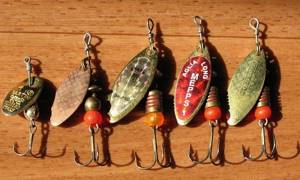
Almost every small spoon can interest a predator, but you should take only the best baits for fishing
Tactics
The tactics of fishing for saberfish with a feeder differ from the usual bottom fishing. This is active work with tackle, often in spinning mode with many casts and pulling.
- Fishing with classic feeder rigs to lower the bait.
- Floating feeders placed in the water column.
- Search fishing with a weight.
- Fishing with a feeder using a bombard, like using a spinning rod.
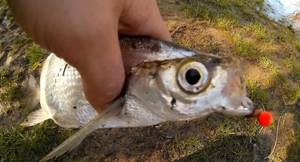
Having arrived at the reservoir, you need to find the places where the saberfish bite, as well as the fishing horizon - from above, in half-water or near the bottom. Depending on the results and activity of the fish, we choose the type of equipment. For example, if a saber fish takes from the surface and is not very active, that is, it does not have time to grab the bait when the feeder is immersed in the bottom, and the depth in the place is large, we use surface equipment. At depths of 2-3 meters (usual points in spring), the equipment can be fixed at the bottom in the usual way in the feeder - with a feeder or a weight. In this case, we then work on selecting the length of the leash and the buoyancy of the nozzle in order to raise the bait to the desired horizon.
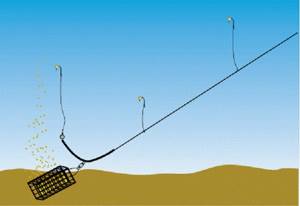
To search, we use the fan method and do not clip. Areas with depths of no more than 4 meters are suitable for the feeder - in order to fix the tackle at the bottom when casting, and lift the bait using foam or floating baits (inflated maggots). In deeper places, if sabrefish are caught from above, it is advisable to use floating feeders or spinning rods in the horizon where the fish takes them.
The main thing is to find fish. She bites sharply on the feeder, immediately grabbing the bait. If there is no frenzied feeding, and the fish move in small schools, we use bait. The sabrefish, like other pelagic fish, primarily reacts visually to turbidity and floating particles. Plus, she's a predator. Therefore, in bait, it is the correct consistency that is important, not the flavor. It is necessary to create a cloudy, exploding cloud with the feeder, into which the saberfish rushes at speed and looks for what to grab in the conditions of food competition in the flock.
Experienced fishermen claim that saberfish prefer quiet, but cloudy and cool weather. The best bite is observed in the morning and evening, in some places at night (in the shallows, closer to the shore). A good bite occurs before a thunderstorm or rain. In spring it usually bites all day.
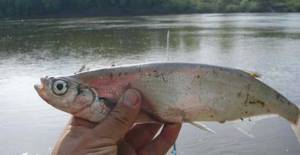
Where to fish
Fishing locations for sabrefish depend on the fishing season and, accordingly, its location in the river. During the pre-spawning run, they are caught mainly from the banks, since the fish in the spring move close to them, hoping to profit from insects, larvae, worms and other food washed into the river.
Attention! Even in such a wide river as the Volga, fishing from the shore during the pre-spawning season is possible with a float rod!
During this period, the main thing is to know where the fish are moving and get out to the river in time. Therefore, you need to prepare gear for sabrefish in the winter, keeping in mind the well-known saying about a sleigh and a cart.
In summer, fish migrate from the upper reaches to their permanent locations. Now the “saber” should be looked for in the following places:
- near deep holes: at the entrance, exit and edge;
- at the boundaries of streams: fast and slow currents, clear and muddy water;
- in deep sections of the river;
- in fast currents near rapids;
- at river bends where reverse currents form;
- in large bays free of vegetation.
At dawn, the fish rise to the upper layers, and during the summer they often even hunt insects on the surface. In the evening, saberfish sink to the bottom of the pits, so they are usually not caught at night.
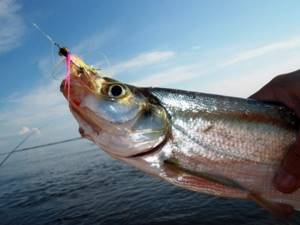
Anglers use frequent rises of sabrefish to the surface when fishing with artificial flies.
In winter, sabrefish sink to the bottom of deep holes and can be caught if there are currents near such locations that vary in strength, purity or composition of water. In this regard, preference should be given to places near channel bends with variable deep bottom topography: steps, pits, navels and similar anomalies.
Feeding
During standard fishing with a feeder, you need to use bait from the bottom to the sanitary fish. In this case, the bait, due to buoyancy and selection of the leash length depending on the depth and strength of the current, is located somewhere in the water column. The bait needs to be light, loose, forming a geyser of dust particles. Such a cloud of turbidity is quickly carried downstream, and the saber fish follows it. Therefore, we use small feeders - it doesn’t matter if after a while it doesn’t bite, we re-throw the tackle again, trying to attract the flock to the cloud again. Feeder for sabrefish - constant frequent casting, creating a cloud of turbidity or a dusty trail (in medium or low currents), like for bleak. The feed should be washed out quickly and explode, so we don’t overcrowd the feeder trough.
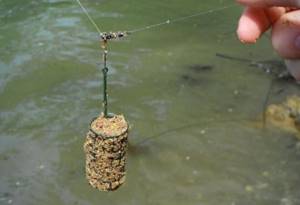
The composition of the bait does not matter - the main thing is the correct consistency. Bait attracts sabrefish more visually; there is no point in bothering with aromatics. It is better to add coconut shavings or sawdust to the feed, which will float when washed out of the feeder feeder. Then one cast works longer - until all the food is completely washed away. You can prepare the mixture using store-bought light mixtures for roach or bleak, or you can also prepare it yourself:
- The base is breadcrumbs, ground cake (makukha).
- Cereal flour - oatmeal, corn, wheat.
- For dregs - powdered milk.
- Floating particles - bran, ground corn sticks, dry fish food (daphnia and cyclops from an aquarium store), coconut shavings, sawdust.
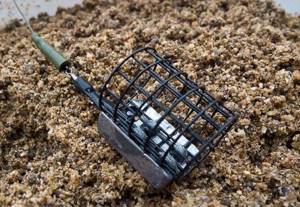
Nozzles
Chekhon is a predatory fish, it feeds on any organisms that it can devour in size, including small fry. She greedily grabs any animal bait on a hook. However, the best option is ordinary maggot. Chekhon has excellent eyesight, and the white color of the larvae stands out well in the water. We also attach a foam ball to the hook to raise the nozzle. Both white and some other color, bright, orange or pink, work. Colored foam, in addition to raising the feeder bait, gives the saberfish an attack point from afar.
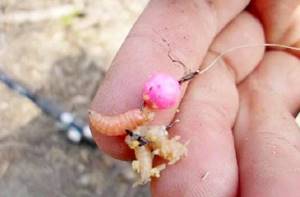
If there is no foam, the maggot can be inflated - each larva separately with a syringe with a thin needle (for example, insulin), or by lightly melting it. When maggots fall into water, they absorb air - this is a natural protection so as not to drown during the rain. Pour water into the jar so that the larvae barely stick out above the surface. If you fill it completely, the maggot will simply die. We wait 5-10 minutes, then pour it all into a large container with water. Larvae that have inflated float to the surface. We select them, put them somewhere separately and use them. You need to hook the inflated maggot by the edge of the thick end of the larva so as not to pierce the body cavity and release the air.
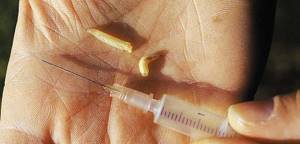
Inflating maggots with a syringe
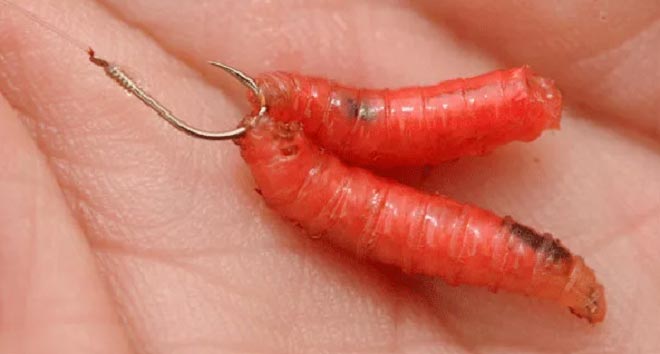
We place the inflated maggot by the edge of the thick part so as not to puncture and release the air.
Maggots are usually the same size. It is this factor that is important, since it allows you to accurately select experimentally a buoyancy system based on the weight of the hook, the length of the leash, the strength of the current and the size of the foam ball. Experimentally we find the ratio of these factors at which it bites. Up to the number of larvae on the hook. If we change the weight of the nozzle, the buoyancy will be different, and the hook with the bait will not rise to the required level or, on the contrary, will float up too much.
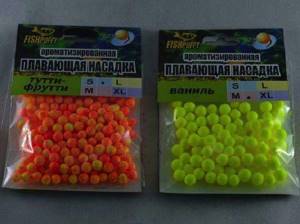
At shallow depths this is not very critical - the saberfish will still see the bait. But sometimes every 10 cm of lift level is important. The saberfish also takes on the worm - it is more difficult to regulate buoyancy. It will grab any insects and larvae attached to the hook of the feeder - as long as the nozzle is correctly delivered to the desired horizon. It can be:
- Any worms and larvae;
- Shrimp meat;
- Mollusks, crustaceans;
- Caddisfly, bloodworm, jig.

We use maggots and polystyrene foam, and don’t bother. We experiment with the size and color of the larvae, a foam ball, inflate the maggot, and select the length of the leash. If it doesn’t bite, it means the place or horizon is chosen incorrectly. Or maybe the fish comes lower to the bait being carried. It’s definitely not a matter of bait – a saber fish will always take a maggot if you spot it.
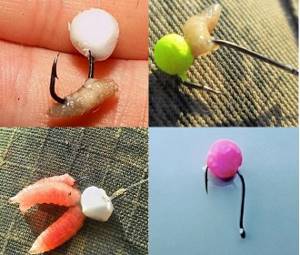
Equipment Features
We select the feeder depending on the conditions of the reservoir - casting distance, current, required weight of the feeder. You can work with either a picker or a heavy river feeder. When fishing for saberfish, equipment and selection of horizon are more important. Fishing is active and requires constant recasting, so it is more convenient to work with light, comfortable gear.
Equipment for catching sabrefish on a feeder can be in any type of installation - paternoster, loop (symmetrical or asymmetrical), inline, helicopter, anti-twist. It is only important to deliver the hook with the nozzle to the desired height. Therefore, an obligatory part of the work is selecting the height of the bait in the thickness. It is easier to work with helicopter feeder equipment, with stoppers instead of knots. The leash on this type of feeder installation sinks more slowly, moreover, the point of its attachment to the base can be raised higher by selecting the desired horizon. Similarly, you can use a paternoster with a long branch to the feeder, up to 70 cm. However, it should be taken into account that the higher we raise the attachment point of the leash, the greater the likelihood of overlap when casting.
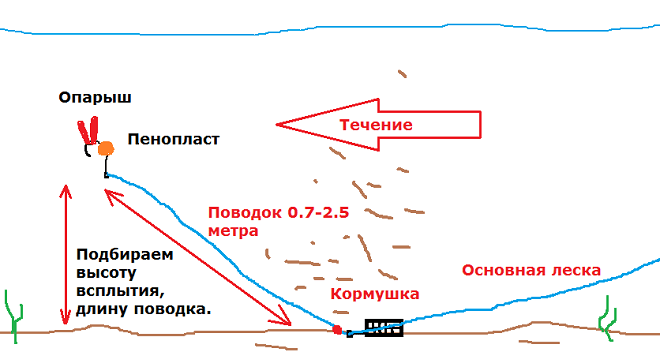
Scheme of operation of the running equipment, symmetrical and asymmetrical loops.
If the current is weak, we mount the feeder equipment for sabrefish on the basis of the lightest feeders so that everything sinks more slowly, giving away as many bait particles as possible during the fall. During the feeding season, you may not even have to bother with selecting the length of the leash and the buoyancy of the feeder attachment - the saber fish will have time to grab the hook as it falls. If it doesn’t bite, we just re-throw the tackle.
To rig the tackle when catching sabrefish with a feeder, we use long leashes, up to 2-3 meters, as long as the length of the rod allows for casting. There is no point in thinning it - sabrefish are not afraid of thick fishing line, but resist stubbornly. You need to drag it forcefully, without giving up any slack, otherwise the fish will tear the weak lip and get away. The normal diameter of the leash line for a sabrefish feeder is 0.16-0.2 mm. Hooks – No. 18-12, based on the size of the nozzle. We choose the size so that when attaching polystyrene foam and 2-3 maggots, the tip remains open.
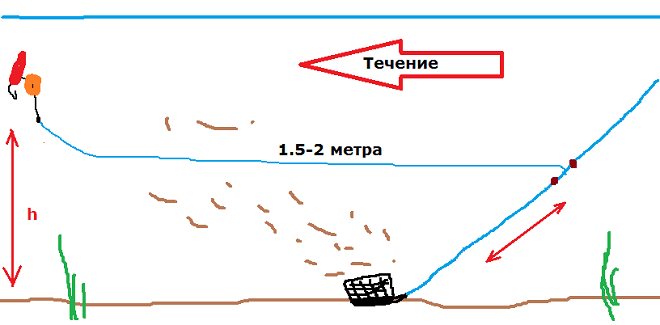
Operation of a paternoster or helicopter
Don't forget to fish actively. If it doesn’t bite for a couple of minutes after casting the feeder, we pull the bait towards ourselves, causing it to oscillate in the flow. Such provocation often provokes a bite. If we are fishing from a bridge, a cape, or a boat, it makes sense to hit the bottom with the feeder, sending the equipment gradually further downstream. After finding the fish and selecting the feeder equipment, you need to catch a certain rhythm of casting, pulling, and then catching sabrefish turns into getting the fish out of the water one by one. You can’t bludgeon and contemplate the quivertip - we are active and experimenting until a fishing system is found. Together with sabrefish, shemai, bleak, roach, and even bream are caught on the feeder in this way.
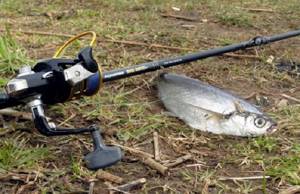
Lures
Features of catching chub with a fly
In this section we will describe artificial baits. Of the natural baits, we note the following:
- bloodworm;
- earthworms or dung worms;
- maggots;
- grasshoppers;
- mayfly butterflies;
- dragonfly;
- various flies;
- gadflies, horse flies;
- bark beetle larvae;
- small bugs;
- fry of carp fish.
Attention! During the summer of some insects, for example, mayflies, catching sabrefish with any other bait is useless. She will only take the butterfly.
It should be noted that in some cases saberfish are caught using various combinations of baits:
- bloodworm + maggot;
- pieces of worm + maggot;
- bark beetle + bloodworm.
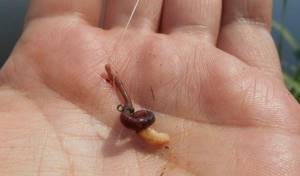
A worm and maggot is a classic sandwich used for catching almost all “white” fish.
In addition, when fishing for saber, you need to experiment with baits, changing the following parameters:
- nozzle method;
- number of larvae;
- bait size.
Floating rig
At short distances, when the fishing point is visible visually, you can fish with floating feeders - Floating Feeder. This is possible in places with a moderately smooth current; fishing is reminiscent of fishing with a float. We insert the plug into the feeder to fill half the volume - fill the rest of the space with food. You can use special massive floats with feeders. You need to select the weight so that when filling with bait, the cormak floats and does not sink. Installation – running, paternoster, helicopter. We cast with a fan, upstream. We fish until the feeder blows down, then we re-cast. At the same time, the bait spills out, and the bait is in a cloud of particles - just what you need for sabrefish.
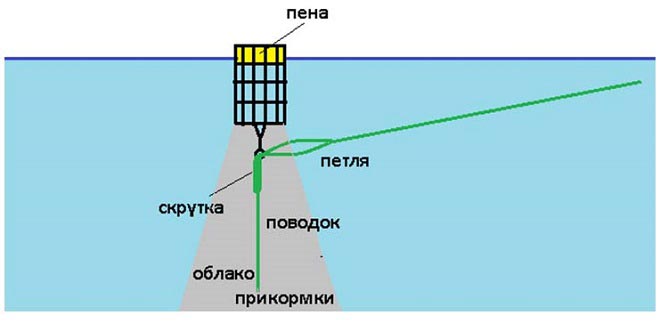
We will still notice the bite of the sabrefish - either by tightening the loop of the fishing line, or by the quiver tip. The length of the leash is a meter or two, depending on the fishing horizon. Accordingly, there is no need to add polystyrene foam to the feeder hook in this type of fishing. This method also works on large bodies of water from a boat, when the fishing spot for sabrefish is known and the fish takes it from above. A floating feeder in such conditions allows you to catch high-riding fish, even if the depth under your feet is 10-20 meters. Read more about floating feeder installations.
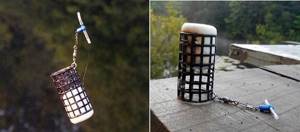
Edible rubber for spinning
Various imitations of crustaceans and shrimp made from edible rubber have become effective baits for catching sabrefish with a spinning rod. Although they do not resemble the insects and crustaceans of our waters in appearance and smell, saberfish still react very actively and positively to these relatively new artificial baits, for example, vibrating tails from Lucky John - Tioga. These are not even vibrotails, but rather worms, but only the smallest ones, no longer than 5 cm. These baits are used most successfully on a retractable leash, since they look more natural on the hook during retrieving. A jig head and even a flexible suspension made of a sinker, a winding ring or a clasp are rougher elements of fastening equipment , which often becomes the cause of a lack of bite, especially if the saber fish are inactive that day.
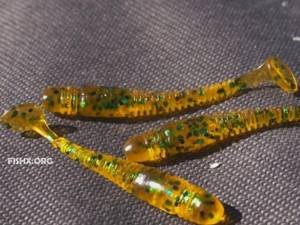
Bombard
On the feeder rod you can put a bombard on the inline principle and a leash with bait. Let's get the sbirulino tackle on the feeder fishing rod. You can fish this way when the fish takes from above. However, it is more comfortable to work with a bombard with a spinning rod. Accordingly, in this method of fishing we do not wait for a bite, but carry out pulls and leads, or drift with the flow.
Read more about catching sabrefish using a bombard
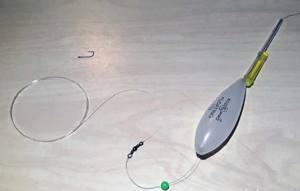
Subscribe to the channel:
YouTube channel RYBAFAN
We are VKontakte
Installation of a bombard on a cover
To prepare gear using a bombard for catching saberfish, you need to select at least two types of them, different in weight, which will be applied to a certain casting distance.
The bombard is installed on the main fishing line or monofilament. It is desirable that the sbirulino float be stationary; for this purpose, locking rings are installed on the fishing line on both sides in the upper and lower parts of the equipment. Then a swivel is attached, preferably with three rotating links, which will eliminate the twisting of the line during wiring. The leash is attached to the swivel. When selecting a thread or fishing line for a leash, use it in a thinner version than the main fishing line, with a length of 1.5 to 3 m. In the final installation process we secure the hooks.
Since casting with a mounted bombard rig requires a certain skill, it is recommended to use one hook with a leash at the initial, learning stages of this type of fishing. In the process of mastering the features of casting and retrieving, two or more additional leashes with hooks are used, on which different baits are baited to determine the most suitable sabrefish for catching in a given area of intended fishing.
The size of the hook used when installing equipment using a bombard is selected experimentally. The most commonly used hooks for catching sabrefish are number four.
